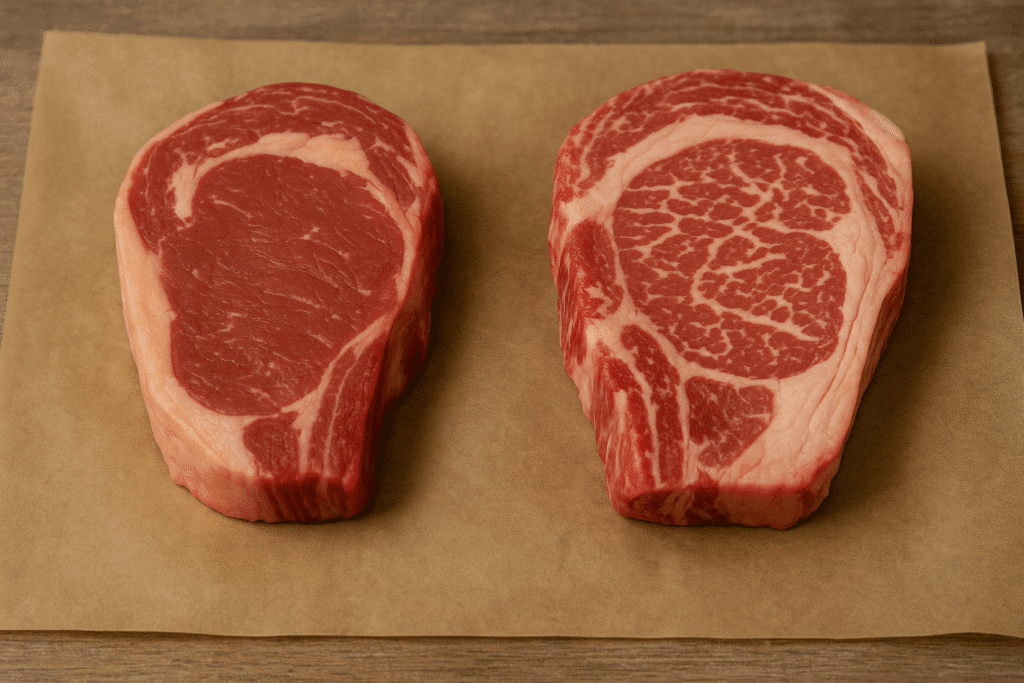The Modern Meat Problem
Most people think all beef is the same.

A hundred years ago, cows spent their days grazing on wild grass. Their meat was naturally rich in omega-3 fats, antioxidants, and vitamins that came straight from the soil. Today, most cattle are packed into feedlots, eating corn and soy their bodies were never designed to handle.
That switch doesn’t just change the cow—it changes what ends up in you. The fatty acids, vitamins, and even the way that fat behaves in your body all shift depending on what the animal ate.
When you eat grain-fed beef, you’re not just eating beef. You’re eating the biology of an animal raised on modern, industrial food.
What Happens When Cows Eat Grass vs. Grain
Cows are ruminants, built to ferment and break down grass. When they’re switched to a high-energy grain diet, their stomach pH drops and their gut bacteria change completely. That might make them gain weight faster, but it also changes the type of fat they produce.
Grass-fed beef ends up higher in omega-3 fats and a compound called CLA (conjugated linoleic acid)—both linked to lower inflammation and better heart health. It also packs more vitamin A, vitamin E, and natural antioxidants.
Grain-fed beef, on the other hand, carries more omega-6 fats—mainly linoleic acid—which are unstable and easily oxidized. That means more inflammatory by-products once they’re inside your body.
Research from Nutrition Journal found grass-fed beef can have up to five times more omega-3s and significantly higher vitamins A and E than grain-fed beef. Newer studies keep confirming it: grass-fed meat simply has a cleaner nutrient profile.
The Omega-6 Problem
Here’s the big picture.
Humans evolved eating an omega-6 to omega-3 ratio close to 1:1. Today, thanks to seed oils and grain-fed meat, it’s closer to 20:1. That imbalance changes how your cells work.
Too much omega-6—especially linoleic acid—gets built into your cell membranes. When it oxidizes, it forms toxic by-products like 4-HNE, which damage mitochondria and mess with hormone production.
Studies show this oxidative stress can affect everything from insulin sensitivity to testosterone levels.
Grass-fed beef doesn’t fix everything on its own, but it shifts the ratio back in your favor—and that matters more than most people realize.
Nutritional Differences at a Glance
| Nutrient | Grass-Fed Beef | Grain-Fed Beef |
|---|---|---|
| Omega-3 (ALA, EPA, DHA) | Much higher | Lower |
| Omega-6 (Linoleic Acid) | Lower | Higher |
| CLA | Higher | Lower |
| Vitamin A | Higher | Lower |
| Vitamin E | Higher | Lower |
| Antioxidant Enzymes | Higher | Lower |
| Total Fat | Leaner, cleaner | More marbled, more unstable fats |
How It Affects Your Health
Switching to grass-fed beef isn’t about chasing labels—it’s about changing what fuels your body.
When your fat intake matches the balance humans evolved with, your metabolism runs cleaner.
- You lower inflammation and oxidative stress.
- Your cholesterol markers actually improve.
- Your hormones regulate more efficiently because your body isn’t overloaded with oxidized fats.
One study in the British Journal of Nutrition found that just six weeks of eating grass-fed beef lowered omega-6 levels and raised HDL cholesterol in participants. The difference showed up in their blood—not just on paper.
Beyond Nutrition: The Regenerative Impact
Grass-fed beef isn’t only better for your biology—it’s better for the planet.
When cattle graze properly, they help restore soil health, rebuild topsoil, and even pull carbon back into the ground. Feedlots do the opposite. They strip the land, overuse grain, and create methane without any carbon return.
Research in Frontiers in Sustainable Food Systems showed that regenerative grazing can offset livestock methane emissions by increasing soil carbon capture. In other words, healthy soil equals cleaner air.
When you buy grass-fed, you’re voting for that kind of system—a loop that supports both human and planetary health.
How to Pick the Right Beef
Not all “grass-fed” labels mean the same thing.
- Look for 100% grass-fed and grass-finished. Many “grass-fed” cows are still fattened on grain at the end.
- Support local or regenerative farms. Brands like Wild Pastures, Force of Nature, and Santa Cruz Paleo all follow transparent sourcing.
- Don’t worry about frozen meat—it keeps its nutrients just fine.
- Cook with tallow or butter, not seed oils. There’s no point in buying clean beef and then drenching it in oxidized oil.
FAQ
Is grain-fed beef unhealthy?
No. It’s still nutrient-dense and better than processed food any day. But its higher omega-6 load adds to the imbalance already driving inflammation in most modern diets.
Can you taste the difference?
Yes. Grass-fed beef tastes more earthy and mineral-rich. Grain-fed has that buttery texture from extra marbling—but that fat isn’t necessarily the good kind.
Is grass-fed beef worth the price?
If you care about long-term health, hormones, and clean fats—it’s worth every bit. You’re not just paying for meat; you’re paying for how that meat was created.
The Bottom Line
Talk to a local butcher and order as much grass-fed meat as you can fit in your freezer and fridge at once. It makes it cheaper, and you know you’ll get more than just the two cuts of steaks you’re used to eating.
Resources:
- Daley, C. A., Abbott, A., Doyle, P. S., Nader, G. A., & Larson, S. (2010). A review of fatty acid profiles and antioxidant content in grass-fed and grain-fed beef. Nutrition Journal, 9(1), 10.
- Duckett, S. K., Neel, J. P. S., Sonon, R. N., Fontenot, J. P., Clapham, W. M., & Scaglia, G. (2022). Fatty Acid Composition of Grain- and Grass-Fed Beef and Their Nutritional Implications. Foods, 11(5), 646.
- Butler, G. (2021). Forage-fed cattle point the way forward for beef? Trends in Food Science & Technology, 112, 1–7.
- Practical Farmers of Iowa. (2021). Carcass Characteristics, Meat Quality, and Fatty Acid Composition of 100% Grass-Fed Beef.
- White, R., & Hall, M. B. (2022). Regenerative Grazing and Carbon Sequestration: The Role of Livestock in Climate Solutions. Frontiers in Sustainable Food Systems, 6, 863174.
- Healthline. (2023). Grass-Fed vs. Grain-Fed Beef: What’s the Difference?
- MDPI Foods. (2022). Nutritional Benefits from Fatty Acids in Organic and Grass-Fed Beef. Foods, 11(5), 646.

Leave a Reply